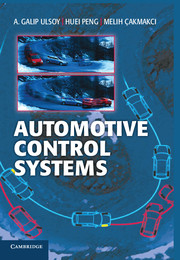Book contents
- Frontmatter
- Contents
- Preface
- Part I Introduction and Background
- Part II Powertrain Control Systems
- Part III Vehicle Control Systems
- 12 Cruise and Headway Control
- 13 Antilock Brake and Traction-Control Systems
- 14 Vehicle Stability Control
- 15 Four-Wheel Steering
- 16 Active Suspensions
- Part IV Intelligent Transportation Systems
- Appendices
- Index
- References
12 - Cruise and Headway Control
Published online by Cambridge University Press: 05 June 2012
- Frontmatter
- Contents
- Preface
- Part I Introduction and Background
- Part II Powertrain Control Systems
- Part III Vehicle Control Systems
- 12 Cruise and Headway Control
- 13 Antilock Brake and Traction-Control Systems
- 14 Vehicle Stability Control
- 15 Four-Wheel Steering
- 16 Active Suspensions
- Part IV Intelligent Transportation Systems
- Appendices
- Index
- References
Summary
One of the most widely adopted and visible control systems available on contemporary vehicles sold in the United States is the cruise control, which automatically regulates the vehicle longitudinal velocity by throttle adjustments. Typically, a vehicle cruise-control system is activated by a driver who wants to maintain a constant speed during long highway driving. This relieves the driver from having to continually adjust the throttle. The driver activates the cruise controller while driving at a particular speed, which then is recorded as the desired (or set-point) speed to be maintained by the controller.
Intelligent cruise control systems – also known as autonomous or adaptive cruise control (ACC) systems – are the next-generation product for cruise control. When no lead vehicle is within sight, an ACC vehicle behaves like a conventional cruise-control vehicle by maintaining a constant (i.e., target) speed. However, an ACC vehicle also has a headway-control mode. When the vehicle, using a range sensor, detects that it is close to the in front vehicle, the controller switches to headway-control mode and adjusts the speed to maintain a desired (i.e., safe) headway. Many field tests have been conducted to assess the real-life performance of ACC vehicles and consumers generally are receptive to the convenience provided by them. A rapidly growing number of luxury vehicles now offer ACC as an option.
- Type
- Chapter
- Information
- Automotive Control Systems , pp. 213 - 231Publisher: Cambridge University PressPrint publication year: 2012

